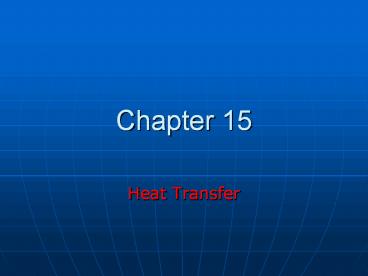Heat Transfer - PowerPoint PPT Presentation
Title:
Heat Transfer
Description:
Heat flows naturally from hot to cold objects. ... Cooling automobile engines. Algal blooms in ponds and lakes. Convection Current Example ... – PowerPoint PPT presentation
Number of Views:90
Avg rating:3.0/5.0
Title: Heat Transfer
1
Chapter 15
- Heat Transfer
2
Second Law of Thermodynamics
- Heat flows naturally from hot to cold objects.
Heat will not flow spontaneously from cold object
to hot object.
3
Methods of Heat Transfer
- Need to know the rate at which energy is
transferred - Need to know the mechanisms responsible for the
transfer - Methods include
- Conduction
- Convection
- Radiation
4
Conduction
- The transfer can be viewed on an atomic scale
- It is an exchange of energy between microscopic
particles by collisions - Less energetic particles gain energy during
collisions with more energetic particles - Rate of conduction depends upon the
characteristics of the substance
5
Conduction example
- The molecules vibrate about their equilibrium
positions - Particles near the stove coil vibrate with larger
amplitudes - These collide with adjacent molecules and
transfer some energy - Eventually, the energy travels entirely through
the pan and its handle
6
Conduction, cont.
- In general, metals are good conductors
- They contain large numbers of electrons that are
relatively free to move through the metal - They can transport energy from one region to
another - Conduction can occur only if there is a
difference in temperature between two parts of
the conducting medium
7
Conduction, equation
- The slab allows energy to transfer from the
region of higher temperature to the region of
lower temperature - Rate of heat transfer (L?x)
8
Conduction, equation explanation
- A is the cross-sectional area
- L ?x is the thickness of the slab or the length
of a rod - ?Q is in Joules and ?t is in seconds
- k is the thermal conductivity of the material
- Good conductors have high k values and good
insulators have low k values
Good copper k385 W/mC Intermediate concrete
k0.8 W/m C Insulator air k0.024 W/m C
9
Example
- 3mX15m concrete wall is 30 cm thick.
- Outside surface 10 C, inside 20 C. What rate
does heat transfer through it? (k40x10-4
cal/cmsC for concrete)
10
Example
- What is equivalent thickness of glass wool?
(k9.3x10-5 cal/cmsC for glass wool)
Glass wool is a much better insulator than
concrete!!
11
Example
- 30 cm concrete house wall with 2.0 cm wood
paneling. 10 C outside and 18C inside.What is
temperature _at_ wood/concrete interface? - (k2.4x10-4 cal/cmsC for wood)
12
Home Insulation
- Substances are rated by their R values
- R L / k L in inches,
- k in BTUin/ft2hourF
- For multiple layers, the total R value is the sum
of the R values of each layer - Wind increases the energy loss by conduction in a
home
Glass wool k0.27 BTU in/(ft2 hour
F) R(1/k)thickness 3.7thickness
13
Conduction and Insulation with Multiple Materials
- Each portion will have a specific thickness and a
specific thermal conductivity - The rate of conduction through each portion is
equal
14
Example
- 7 ft2 sheet of material allows 80 BTU to flow
through it in 40 minutes when temperature
difference across it is 35F. What is R-value for
the sheet?
15
Convection
- Energy transferred by the movement of a substance
- When the movement results from differences in
density, it is called natural convection - When the movement is forced by a fan or a pump,
it is called forced convection
16
Convection example
- Air directly above the flame is warmed and
expands - The density of the air decreases, and it rises
- The mass of air warms the hand as it moves by
17
Convection applications
- Boiling water
- Radiators
- Upwelling
- Cooling automobile engines
- Algal blooms in ponds and lakes
18
Convection Current Example
- The radiator warms the air in the lower region of
the room - The warm air is less dense, so it rises to the
ceiling - The denser, cooler air sinks
- A continuous air current pattern is set up as
shown
19
Heat Transfer by Convection
- ?T temperature difference
- A area of contact
- h convection surface coefficient
20
Example
- Heat transfer from glass to outside through
convection. Assume window area to be 1 m2, glass
temperature 5 C and outside temperature 15C.
For air in contact with solid surface h1.5-2.5
W/m2C. Amount of heat - lost in a day?
21
Radiation
- Radiation does not require physical contact
- All objects radiate energy continuously in the
form of electromagnetic waves due to thermal
vibrations of the molecules - Rate of radiation is given by Stefans Boltzmann
Law
22
Radiation example
- The electromagnetic waves carry the energy from
the fire to the hands - No physical contact is necessary
- Cannot be accounted for by conduction or
convection
23
Radiation equation
- The power is the rate of energy transfer, in
Watts - s 5.6696 x 10-8 W/m2.K4
- A is the surface area of the object
- e is a constant called the emissivity
- e varies from 0 to 1
- T is the temperature in Kelvins
24
Example
- A square steel plate 10 cm on a side at
- 800 C. Find the rate of heat radiated.
- In one hour?
25
Example
- Temperature of a hot plate is doubled from 100 C
to 200 C. How is the rate of heat radiated
changed?































